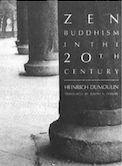ZEN BUDDHISM IN THE 20TH CENTURY
By Heinrich Dumoulin.
Weatherhill: New York and Tokyo, 1992.
167 pp. $14.95 (paperback).
Dumoulin, a German scholar, is best known in America for his incarnation being the two volume Zen Buddhism: A History (Macmillan: 1988). Their comprehensiveness and scholarly accuracy (rather than innovative analysis) have made them staple resources for students of Zen.
Zen Buddhism in the 20th Century may have been more accurately titled “Reflections on a few aspects of the encounter between Zen and the West.” Choosing only a few possible contexts of this interaction, Dumoulin rarely probes the issues and ideas involved.
Underlying these accounts is Dumoulin’s own passionate religious concern. A Jesuit priest as well as a serious Zen student, he feels that contemporary culture is crippled with problems of technology, materialism, and the age-old Western mind-body split. But he also sees this as a time of immense religious possibility, primarily in the interchange between Zen and the West. One chapter, “Zen Philosophy and Western Thought,” introduces several representatives of the Kyoto School, an ongoing group of twentieth-century Japanese philosophers steeped in both Western philosophy and Zen. While most of this section is made up of brief accounts that note the specific religious posture of each thinker, in the last two sections (on Nishitani Keiji and Ueda Shizuteru) Dumoulin finally enters into extended interpretation and analysis. With these thinkers, for the first time, Zen arrives at full philosophical reflection. Animating his discussion is Dumoulin’s belief that this “philosophy of Zen … tackles central human problems in a manner that appeals to modern culture … [and] it roots these concerns in a practice inspired by existential anxiety and care.”
The chapter “Research on Zen” discusses two very different kinds of Western studies: those by Buddhist scholars and those by psychologists. Dumoulin presents summaries of recent revisions in our understanding of the historical development of early Zen. This secondhand scholarly reporting seems a bit out of place in the book, but offers valuable corrections to our understanding of the short-lived Northern School of Zen, much maligned by its Southern competitor, from which the Rinzai and Soto sects have developed.
Dumoulin moves from scholarly concerns to a discussion of psychological research into Zen. He affirms that scientific analysis of brain waves during meditation “reveals with precision the psychosomatic totality of the person,” a Zen insight he feels we desperately need. Turning to a review of how Jung and Fromm interpreted Zen, he also provides an account of Morita therapy, a modern Japanese psychotherapy influenced by Zen. He suggests how both Fromm’s humanistic psychoanalysis and Morita therapy can be helpful, but avoids interesting questions such as whether Fromm is correct in claiming that psychoanalysis and Zen have the same goals, and in what way Morita psychotherapy and Zen practice differ.
Dumoulin is most engaged with his subject in the final chapter, “Zen Meditation in Christian Perspective.” He points to intriguing—though vague—”proximities” between Zen and Christianity (which here means the contemplative tradition of Catholicism). His review of European Christian interactions with Zen indicates that rich cross-fertilization has been occurring in continental Europe. His interest here is not principally philosophy or theology and so he ignores the Buddhist-Christian dialogue among scholars. Instead he is concerned with praxis: how can Christian practice benefit from familiarity with Zen?
In the epilogue Dumoulin presents his hope that the pluralism of Zen practice itself, as well as the pluralism involved in the encounter of Zen and Christianity, will generate understanding; but he expresses a concern that this pluralism might be a pretext for a disspation of energy. Appropriately, the book leaves the reader with an implicit question: what will be the nature of the next hundred years of the interchange between Zen and the West?
Thank you for subscribing to Tricycle! As a nonprofit, we depend on readers like you to keep Buddhist teachings and practices widely available.